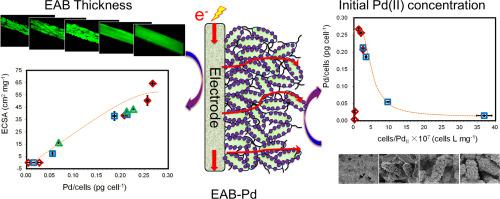Science of the Total Environment ( IF 9.8 ) Pub Date : 2020-06-26 , DOI: 10.1016/j.scitotenv.2020.140536 Ya-Nan Hou 1 , Jin-Feng Ma 2 , Zhen-Ni Yang 3 , Su-Yun Sun 2 , Ai-Jie Wang 4 , Hao-Yi Cheng 5

|
Biogenic palladium (bio-Pd) nanoparticles have been considered as promising biocatalyst for energy generation and contaminants remediation in water and sediment. Recently, an electroactive biofilm-Pd (EAB-Pd) network, which can be used directly as electrocatalyst and show enhanced electrocatalytic performance, has exhibited tremendous application potential. However, the information regarding to the controllable biosynthetic process and corresponding catalytic properties is scarce. This study demonstrated that the catalytic performance of EAB-Pd could be influenced by Pd loading on bacteria cells (Pd/cells), which was crucial to determine the final distribution characteristic of Pd nanocrystal on EAB skeleton. For instance, the high Pd/cells (over 0.18 pg cell−1) exhibited almost 6-fold and 1.5-fold enhancement over EAB-Pds with Pd/cells below 0.03 in catalytic current toward hydrogen evolution reaction and nitrobenzene reduction, respectively. In addition, the Pd/cells was found to be affected by the synthesis factors, such as the ratio of biomass to initial Pd(II) concentration (cells/PdII) and the exposure time of EAB to Pd(II) precursor solution. The Pd/cells increased significantly as the cell/PdII ratio decreased from ~5.5 × 107 to ~1.3 × 107 cells L mg−1 or the prolongation of exposure time from 3 h to 24 h. The findings developed in this work extensively expand our knowledge for the in-situ designing biogenic electrocatalyst and provide important information for the development of its catalytic property.
中文翻译:

深入了解原位制备的电活性生物膜-Pd的电催化性能:生物膜厚度,初始Pd(II)浓度和对Pd前体的暴露时间的作用。
生物钯(bio-Pd)纳米颗粒被认为是有前途的生物催化剂,可用于水和沉积物中的能量产生和污染物修复。近年来,可直接用作电催化剂并显示出增强的电催化性能的电活性生物膜-钯(EAB-Pd)网络具有巨大的应用潜力。但是,关于可控的生物合成过程和相应的催化性能的信息很少。这项研究表明,EAB-Pd的催化性能可能受Pd负载在细菌细胞(Pd /细胞)上的影响,这对于确定Pd纳米晶体在EAB骨架上的最终分布特征至关重要。例如,高Pd / cells(超过0.18 pg cell -1)在Pd /细胞低于0.03的催化电流中,分别向EAB-Pds展示了近6倍和1.5倍的增强。此外,发现Pd /细胞受合成因素的影响,例如生物量与初始Pd(II)浓度的比值(细胞/ Pd II)以及EAB在Pd(II)前体溶液中的暴露时间。将Pd /细胞显著增加作为细胞/钯II比为〜5.5×10降低7至〜1.3×10个7传感器L毫克-1或将曝光时间从3小时延长到24小时。这项工作中发现的发现广泛扩展了我们在原位设计生物电催化剂方面的知识,并为开发其催化性能提供了重要的信息。



























 京公网安备 11010802027423号
京公网安备 11010802027423号